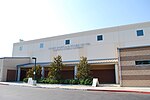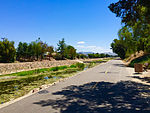Santa Rosa Valley, California
Santa Rosa Valley is a rural unincorporated community, named after the eponymous valley in which it lies, located in Ventura County, California, United States. For statistical purposes, the United States Census Bureau has defined Santa Rosa Valley as a census-designated place (CDP). The census definition of the area may not precisely correspond to local understanding of the area with the same name. The 2010 United States census reported Santa Rosa Valley's population was 3,334. Santa Rosa Valley sits at an elevation of 433 feet (132 m).It lies within the County of Ventura north of Newbury Park, between Thousand Oaks and Camarillo. Norwegian Grade, which was constructed by the Norwegian Colony, connects Santa Rosa Valley to Thousand Oaks, while it may be reached from Santa Rosa Road in Camarillo. The Santa Rosa Valley lies right north of the Conejo Valley and along the Arroyo Santa Rosa and Arroyo Conejo. Most of the area consists of agricultural lands and it is home to a variety of wildlife such as bobcats, gray foxes, mule deer, coyotes, and more. The valley is likely the habitat for more than one Mountain lion, and lions are relatively often observed here. Immediately to the south is the Conejo Canyons Open Space, with trails leading to the Arroyo Conejo Nature Preserve (La Branca) and Hill Canyon, and the community also borders Mount Clef Ridge and Wildwood Regional Park to the south.Santa Rosa Valley was home to a Chumash village in pre-colonial times, known as Šumpaši, which was located by Conejo Creek.
Excerpt from the Wikipedia article Santa Rosa Valley, California (License: CC BY-SA 3.0, Authors).Santa Rosa Valley, California
Redondo Avenue,
Geographical coordinates (GPS) Address Nearby Places Show on map
Geographical coordinates (GPS)
| Latitude | Longitude |
|---|---|
| N 34.245277777778 ° | E -118.90222222222 ° |
Address
Redondo Avenue 2781
93012
California, United States
Open on Google Maps








